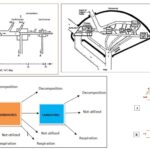Biochemistry 3 Views 1 Answers
Sourav PanLv 9April 18, 2025
What happens in Krebs cycle?
What happens in Krebs cycle?
Please login to save the post
Please login to submit an answer.
Sourav PanLv 9May 15, 2025
In the Krebs cycle, acetyl-CoA (a 2-carbon molecule) combines with oxaloacetate (a 4-carbon molecule) to form citrate (a 6-carbon compound). The cycle then undergoes a series of enzyme-driven steps, involving decarboxylation and oxidation, which generate 3 NADH, 1 FADH₂, 1 ATP (or GTP), and release 2 CO₂ molecules. The cycle regenerates oxaloacetate, allowing it to accept another molecule of acetyl-CoA and repeat.
0
0 likes
- Share on Facebook
- Share on Twitter
- Share on LinkedIn
0 found this helpful out of 0 votes
Helpful: 0%
Helpful: 0%
Was this page helpful?




